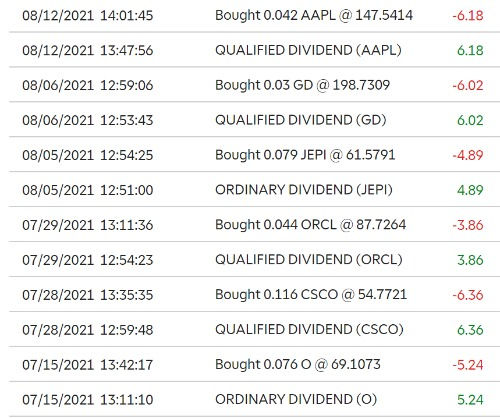Ordinary Dividends vs Qualified Dividends: Understanding Dividend Taxation
- Joe Shedd

- Aug 27, 2021
- 7 min read
Updated: May 25, 2023

For novice dividend investors, the distinction between qualified dividends and ordinary dividends often remains shrouded in uncertainty. However, understanding the intricacies of dividend taxation is paramount, particularly for those who do not utilize tax-advantaged accounts such as 401(k)s. This article serves as an invaluable resource specifically tailored to individuals navigating the world of US taxable brokerage accounts.
So, what sets qualified dividends apart from their ordinary counterparts? The distinction lies in how these payments are scrutinized by the watchful eye of the taxman, Uncle Sam. Ordinary dividends, true to their name, are subject to taxation at your regular income tax rate, much like any other source of income. They dutifully contribute their fair share, without any preferential treatment. In contrast, qualified dividends enjoy a more favorable tax rate, typically lower than the standard income tax rates. It's as if they possess a golden key, unlocking access to a select group of tax-exempt benefits.
Within this article, we unravel the enigma of dividend taxation, shedding light on the nuances that differentiate qualified dividends from their ordinary counterparts. In a deliberate and meticulous manner, we navigate the intricate landscape of rules and regulations governing dividend taxation. Brace yourself for a deep dive into the inner workings of qualified and ordinary dividends, equipping you with the knowledge necessary to make informed investment decisions.
Discover a treasure trove of valuable insights and knowledge at our Resource Center. Explore a wealth of information on dividends investing, retirement planning, dividend stock analysis, and a wide range of other finance topics that will empower you on your financial journey.
What are capital gains taxes and how do they apply to dividends?
Are you scratching your head in bewilderment when it comes to taxes in your taxable account? Fear not, for we're about to shed light on this complex subject. Let's start by unraveling the intricacies of selling stocks for a profit, where the concept of "capital gains" takes center stage. Brace yourself for a journey into the world of taxation, where holding periods and income brackets intertwine.
When you sell a stock and make a profit, you're essentially realizing capital gains. These gains fall into two distinct categories, each with its own tax implications:
Short-Term Capital Gains: If you held the stock for less than one year, any profit you earn will be subject to short-term capital gains tax at your applicable federal income tax rate. This rate can range from 10% to 37%, depending on your income level.
Long-Term Capital Gains: Conversely, if you held the stock for longer than one year, the profits you generate will be taxed at the long-term capital gains rate. This rate is determined by your income and filing status and can be either 0%, 15%, or 20%. It's a more favorable tax rate.
To make things clearer, your brokerage account will typically indicate whether your stock position is classified as short or long within your portfolio. This classification refers to the holding periods mentioned above. However, it's crucial to note that this terminology should not be confused with "shorting" a stock, which is an entirely different concept that warrants its own dedicated discussion.
To illustrate this further, let's take a glimpse at an example from my own portfolio. Notice how my Apple stock ($AAPL) shares display both long and short positions. For instance, the two Apple shares purchased on November 11, 2020, will transition into a long position on the same date in 2021. Your brokerage account should provide similar information, ensuring clarity regarding the tax implications associated with your holdings.designed to reward long-term investors.

As we delve deeper into the intricacies of taxation within your taxable account, it's important to consider the potential impact on your overall financial strategy. By understanding the distinction between short-term and long-term capital gains, you can make informed decisions that align with your investment goals and tax optimization objectives.
Ordinary Dividends VS Qualified Dividends: How are Dividend distributions taxed?
When it comes to dividend distributions, understanding the different types is crucial. Excluding special dividends, dividend income can be categorized into two main types: qualified dividends and ordinary dividends. Let's delve into the intricacies of each, shedding light on their taxation and holding requirements.
Qualified Dividends take the spotlight as a tax-savvy option. They are treated as long-term capital gains, subject to federal income tax rates of 0%, 15%, or 20%, depending on your income level. This favorable tax treatment applies to the majority of dividends. However, there is a specific holding period requirement to qualify for this beneficial treatment.
According to the Internal Revenue Service (IRS) guidelines, common stock investors must hold their shares for more than 60 days during a 121-day period that starts 60 days before the ex-dividend date. This period is crucial as it determines eligibility for receiving qualified dividends. For preferred stock, the holding period extends to more than 90 days during a 181-day period that starts 90 days before the ex-dividend date. Meeting these holding requirements ensures that your dividends fall into the qualified category. Explained in simpler terms:
To qualify for better tax treatment called "qualified dividends," you need to follow some rules:
If you have regular stocks, hold them for at least 60 days during a 121-day period that starts 60 days before the company pays out the dividend.
If you have a different type of stock called preferred stock, hold it for more than 90 days during a 181-day period that starts 90 days before the dividend payment.
By following these rules and holding your stocks for the required time, you can get qualified dividends. Qualified dividends have lower taxes, which means you get to keep more of the money you earn from dividends.
On the other hand, Ordinary Dividends are subject to taxation at your federal income tax bracket, similar to short-term capital gains. They do not enjoy the advantageous tax rates granted to qualified dividends. Ordinary dividends typically arise from various sources, such as not meeting the IRS guidelines for holding stock, Real Estate Investment Trusts (REITs), Covered Call ETFs, and others.
To provide clarity regarding the type of dividend you received, your brokerage account will specify the classification. For instance, in the example below, qualified dividends were received from holdings in $AAPL, $GD, $ORCL, and $CSCO. On the other hand, ordinary dividends were earned from $JEPI and $O. Note that negative numbers indicate the automatic dividend reinvestment plan (DRIP) implemented by my brokerage, where dividends are immediately reinvested to acquire more shares.

You can also use a website like dividend.com to tell you if a company pays qualified or ordinary dividends. Below is an example of Apple Stock ($AAPL).
Let's say you have invested in two different stocks, Stock A and Stock B. Both stocks pay dividends, but Stock A's dividends are classified as ordinary dividends, while Stock B's dividends are considered qualified dividends. Here's how it can impact your dividend income:
Ordinary Dividends: Now, let's say you received $10,000 in ordinary dividends from Stock a. Since ordinary dividends are taxed at your regular income tax rate, let's assume your income tax rate is 25%. In this scenario, you would owe $2,500 in taxes on the $10,000 dividend income. After taxes, you would be left with $7,500 of the dividend income.
Qualified Dividends: Suppose you received $10,000 in qualified dividends from Stock B. Since qualified dividends have more favorable tax treatment, let's assume the tax rate for qualified dividends is 15% (The max amount for qualified dividends). In this case, you would owe $1,500 in taxes on your $10,000 dividend income. You would be able to keep $8,500 of the dividend income after taxes.
As you can see from this example, the classification of dividends as either qualified or ordinary can have a significant impact on your dividend income after taxes. Qualified dividends are subject to lower tax rates, allowing you to retain a higher portion of your dividend earnings compared to ordinary dividends, which are taxed at your regular income tax rate.
If your brokerage doesn't have the information or you are looking into a new stock you can use a websites like Dividend.com to determine whether a company pays qualified or ordinary dividends. These websites provide valuable information about dividend classifications, empowering you to make informed investment decisions. Let's take a closer look at an example featuring Apple Stock ($AAPL) to illustrate how these platforms can assist you.
Conclusion
In this article we explored Ordinary Dividends vs Qualified Dividends and we learned that in the realm of taxable accounts, it becomes imperative to grasp the intricacies of taxes and how they apply to your dividend earnings. Unlike employment income, where taxes are automatically deducted by your employer, the responsibility of paying taxes on dividends rests squarely on your shoulders. As the year comes to a close, you'll owe taxes on the dividends you received, making it crucial to prepare accordingly. The key is to be prepared for them by being informed. At the end of the year your brokerage will provide you with essential tax paperwork to assist you in filing your taxes accurately. However, it's important to note that your broker will not automatically pay your taxes on your behalf. The onus lies on you to fulfill your tax obligations diligently.
To navigate this process effectively, prudent financial planning comes into play. For instance, let's consider a hypothetical scenario: I find myself in the 22% tax bracket. To ensure I'm well-prepared for my tax obligations, I set aside an appropriate portion of my dividend income in my bank account each month. By doing so, I am proactively reserving funds to cover the taxes I will owe at the end of the year. As your investment portfolio grows and your dividend income increases, it becomes even more important to strategize your financial moves.
Always remember that staying informed and proactive in managing your tax obligations is crucial for a successful investment journey. By understanding the implications of taxes on your dividend income and taking appropriate measures to plan and allocate funds, you can navigate the complex landscape of taxation with confidence and optimize your returns.
Join the conversation and stay in the loop with the latest investment insights, dividend strategies, and tax tips by following me on Twitter.


Comments